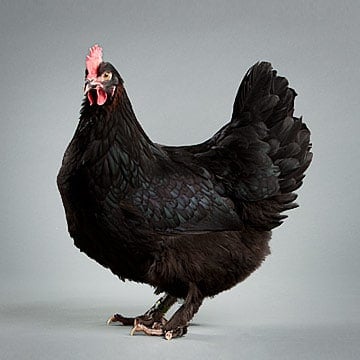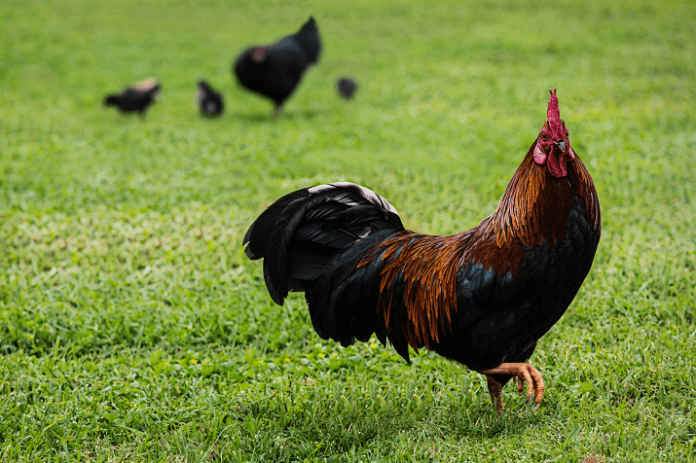Last Updated on July 2, 2021 by Fumipets
The Black Copper Marans chicken is a lovely bird that produces very dark, chocolate-coloured eggs that are trendy at the moment.
Although it has only been around for about a century (1900 or so), it has had a turbulent history marked by ups and downs as well as near extinction.
There are various types of Marans, but the Black Copper Marans have lately gained popularity in the United States.
The English have been drawn to the Marans breed since it was said to be James Bond’s favourite egg!
We’ll go through the history of Black Copper Marans before looking at their behaviour and egg-laying capacity in this comprehensive breed guide.

Overview
| Black Copper Marans Chicken | |
|---|---|
| Beginner Friendly: | Yes. |
| Lifespan: | 8+ years. |
| Weight: | Hen (6.5lb) and Rooster (8lb). |
| Color: | Black and Copper. |
| Egg Production: | 3 per week. |
| Egg Color: | Dark Red or Chocolate. |
| Known For Broodiness: | Average. |
| Good With Children: | Average. |
| Cost of Chicken: | $10-60 per chick. |
Background and History
The original Marans (poule de Marans) is from the southwestern French city of La Rochelle. Because the region is low and swampy, the local chickens were dubbed “swamp chickens.”
These initial landrace birds were mixed with local barnyard chickens and gamecocks brought in by the sailors from India and Indonesia. They swapped gamecocks for fresh food and water, so they were always in short supply.
Marandaise chicken was the name given to these originals.
Croad Langshan, Brahmas, Coucou de Malines, Coucou de Rennes, and Gatinaise hens subsequently refined the Marans to form the progenitors of the Maran breed we know today.
The rich red colour of the Marans’ eggs became well-known in France; their plumage, on the other hand, was all over the place.
A certain Mrs Rousseau began breeding in 1921 to unify the plumage, resulting in the cuckoo Marans, which are still popular today.
In France, the breed standard for this dual-purpose bird was established in 1930. Marans was the name given to them after the French port of the same name.
Silver cuckoo, white/black, black copper neck, ermine, golden cuckoo, and red were the six known types of Marans by 1932.
Moving ahead to post-World War II France, the breed was in shambles and almost extinct.
It was saved from obscurity by the French Department of Agriculture, which initiated a breeding program.
One of the program’s objectives was to boost egg production, which it achieved. Marans were generating roughly 200 eggs each year by 1952.
When the experiment ended, many amateur enthusiasts took up the cause of the Marans and did a fantastic job of preserving and developing the breed.

Appearance and Breed Requirement
When seen from the side, the Black Copper Marans’ body creates a broad ‘V’ triangle. The body is solid, powerful, and lengthy. They should have a broad shoulder width.
They have a stunning plumage. The general colour of the body feathers is dark black, with a green colouration in the sunshine.
Hackle feathers have a reddish/coppery tone to them. Copper saddle feathers flow down the rooster’s back as well. While the hen isn’t nearly as well-dressed, it’s still a lovely bird. Clean-legged Black Copper Marans are common.
The males weigh roughly 7-8 pounds, while the hen weighs approximately 6.5 pounds. Bantam Marans do exist, but they are rare and difficult to get by.
The American Poultry Association recognized the Black Copper Marans in 2011 – a newcomer! The clean-legged Marans, on the other hand, were welcomed into the British Poultry Club in 1935.
Marans comes in nine different kinds in its native nation of France.
The Marans varieties’ criteria might vary a lot from nation to nation. It is a huge fowl breed that is designated as a ‘Continental’ breed.
Clean-legged birds are the standard in the United Kingdom. On the other hand, both clean-legged and sparingly feathered legs are accepted in France and the United States.
The wattles, ear lobes, and cheeks are all crimson, as is the solitary comb. The beak is thick and has a small hook, and it should be horn-coloured. The eyes are orange in colour. Shanks and feet should be slate or pink, with white soles to match the bird’s skin.
The plumage of the Black Copper must be red, with no mahogany or yellow/straw tones.
The male should have a black-breasted crimson chest with minor spotting. On the wings, there should be a distinct black triangle, and he should have deep crimson shoulders. Lancets are the copper-coloured feathers seen in the neck, hackles, and back. The hen is black with red hackle markings, with very little redbreast marks acceptable.
Yellow shanks, white ear lobes, black eyes, ‘off’ colouration, and ‘over’ feathering of the legs are all common flaws in this species.

Disposition and Temperament
Although the roosters might be aggressive with other roosters, the Black Copper Marans are peaceful and friendly. Although there are some pretty tame roosters available, this accords with the history of gamecock breeding and is to be anticipated to some extent.
The hens are typically docile, though this varies depending on the individual bird. They don’t have a reputation for being a cuddly bird.
They are an energetic bird that prefers foraging and free-ranging, but they may also be kept in captivity. They are also fairly cold hardy, making them appropriate for Northern regions if properly housed and protected.
Eggs Laying and Colour
Copper, black Marans are known for their very dark brown/chocolate coloured eggs. All of Maran’s birds produce dark brown eggs, but the Black Copper is particularly prized for its egg colour, which is particularly “chocolate.”
The deeper the colour, the fewer eggs a Black Copper hen lays. You will not receive the deepest colour on the eggs if your hen is an excellent layer. Because the egg’s pigment overlay is a limited resource, the colour fades as the “ink” runs out. We go about egg colour in further detail here.
Some eggs, like Welsummer eggs, will have the deeper coloured speckles.
Egg colour may also be cyclical; you’ll receive extremely black eggs at the start of the laying season, but they’ll have lightened greatly by the conclusion.
On average, a hen will lay 3 eggs each week, which equates to 150-200 eggs each year.
The Maran is an average layer in terms of quantity, but the egg quality is claimed to be unrivalled.
The hens are known to be excellent setters and moms who aren’t unduly broody.
If you’re looking to purchase Black Copper Marans, here’s a helpful buyer’s tip:
Don’t purchase chickens based on the colour of an egg in a picture. Eggs that have been exposed to the air for a long time will be darker. In the air, the red pigment oxidizes, darkening the colour.
Unscrupulous people who wish to sell you an “average” bird have tried this tactic before. Rely on the breeder’s reputation and whatever comments you may discover.
Feeding
For French Black Copper Marans, a typical 16 percent layer feed is ideal. During stressful periods like molting or chick raising, you may increase the protein percentage.
Allowing them to wander will allow them to replenish their ration by foraging. They are excellent foragers, and the exertion keeps them in shape.
Marans are one of those breeds that, if maintained in captivity, would grow sluggish and fat.
So, if you’re keeping them in a run, make sure they’re fed on a regular basis.
Coop Setup
Marans are huge chickens that will need a lot of coop space.
The typical 4 square feet per chicken would enough, but if you can provide them with a little additional space, that would be preferable.
The roosting area, which should be 8-10 inches per bird, comes next. Throughout the winter, they will be crowded together, but during the summer, they will spread apart.
The regular nesting box (12 by 12 inches) will enough, and one nesting box should be used for every three Marans.
Why You Should Get A Black Copper Marans
The Black Copper Marans will disappoint you if you’re seeking for an egg-laying superstar. The Black Copper Marans, on the other hand, are a stunningly marked hen that produces extremely black eggs.
However, keep in mind that the chickens that produce the darkest eggs also lay the fewest. The lighter the shell colour, the faster the egg travels through the system.
The Marans society has devised a colour scale for eggs ranging from 1 to 9, with 9 being the darkest and allegedly the best — do they taste different? I honestly have no idea. A hen that produces less than four eggs is not classified as a Marans.
Be prepared to spend a lot of money if you want to get your hands on any of these rare gems.
Yes, hatchery birds are cheap, but they pale in comparison to the more costly and higher-quality birds.
A bird from a reputable breeder might cost anything from $30.00 to $ 60.00 per bird — too much? Try some hatching eggs, which cost around $75.00 per dozen.
With other breeds, it might be tough to discern the difference, but not with this one. The plumage should be vibrantly colourful rather than washed out or subdued. The birds should be tall and proud, with powerful shoulders – roosters seem to carry their colours with great regality.
Their enormous combs must be given additional attention if maintained in cooler areas. This comb is tall and stands far away from the rooster’s head. The Maran is more prone to frostbite as a result of this. Frostbite that is severe enough might cause the comb to die.
If you want to see this uncommon species, hatchery chicks may be your best option if you’re on a budget. If you want to win first prize at the exhibition, though, you should consider purchasing a Maran from a recognized breeder.
Breeders like talking about their favourite birds, so spending time with one can only help you learn more about your new feathery companion.

Conclusion
Marans, particularly Black Copper Marans, are still regarded as rare in the United States. In their homeland of France, they are much more frequent.
There’s a reason why these birds are so valuable. It takes a lot of time and work to create such a beautiful bird that can breed true down the line.
With its contrasting black and copper plumage, a high-quality bird is truly stunning.
If you’re serious about acquiring some of these exotic beauties, you should get the finest you can; that way, you’ll be able to work on producing your own high-quality chicks.
Is it all worth it because of the dark chocolate egg? That is entirely up to you to decide.


















